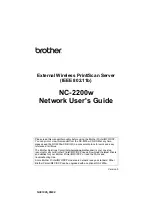
System BIOS
Intel® Server Boards SE7320SP2 and SE7525GP2
Revision
4.0
92
If an ACPI operating system is loaded, the following can cause the system to wake up: the
PME, RTC, or Wake-On-LAN.
Table 46. Supported Wake Events
Wake Event
Supported via ACPI (by sleep state)
Supported Via
Legacy Wake
Power Button
Always wakes system.
Always wakes
system
Ring indicate from Serial A
Wakes from S1 and S4.
Yes
Ring indicate from Serial B
Wakes from S1 and S4. If Serial-B (COM2) is used for
Emergency Management Port, Serial-B wakeup is disabled.
Yes
PME from PCI cards
Wakes from S1 and S4.
Yes
RTC Alarm
Wakes from S1. Always wakes the system up from S4.
No
Mouse
Wakes from S1.
No
Keyboard
Wakes from S1.
No
USB
Wakes from S1.
No
4.10 Security
The BIOS provides a number of security features. This section describes the security features
and operating model.
The BIOS uses passwords to prevent unauthorized tampering with the system. Once secure
mode is entered, access to the system is allowed only after the correct password(s) has been
entered. Both user and administrator passwords are supported by the BIOS. To set a user
password, an administrator password must be entered during system configuration using the
BIOS setup menu. The maximum length of the password is seven characters. The password
cannot have characters other than alphanumeric (a-z, A-Z, 0-9).
Once set, a password can be cleared by entering the password change mode and pressing
enter twice without inputting a string. All setup fields can be modified when entering the
administrator password. The “user access level” setting in the BIOS setup Security menu
controls the user access level. The administrator can choose “No Access” to block the user from
accessing any setup features. “Limited Access” will allow only the date/time fields and the user
password to be changed. “View Only” allows the user to enter BIOS setup, but not change any
settings.
Administrator has control over all fields in the setup, including the ability to clear the user
password.
If the user enters three wrong passwords in a row during the boot sequence, the system will be
placed into a halt state. This feature makes it difficult to break the password by “trial and error.”
The BIOS Setup may provide an option for setting the EMP password. However, the EMP
password is only utilized by the mBMC; this password does not affect the BIOS security in any
way, nor does the BIOS security engine provide any validation services for this password. EMP
security is handled primarily through the mBMC and EMP utilities.
Summary of Contents for SE7320SP2 - 800MHZ Ecc Ddr Xeon
Page 182: ......
















































